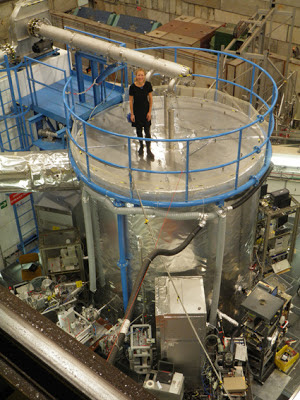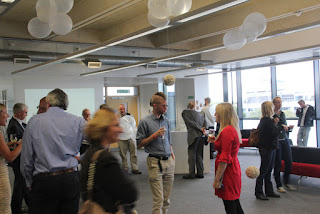I am delighted that one of the copper plates I produced at CERN last week is now on their gallery page. Here are some of the other breath's I recoded whilst there:
http://arts.web.cern.ch/gallery
Wednesday 12 December 2012
Wednesday 28 November 2012
Tuesday 27 November 2012
On top of a Cloud
Whilst at CERN I had the privilege of meeting Jasper Kirkby and his team and seeing- and infact standing on- Cloud- a total contrast in scale and technology to our Brunel cloud chamber! I was able to show the team Darkness Visible, the film made in celebration of 100 years of the discovery of cosmic rays. I look forward to seeing in future visualisations from within Cloud.
Breathing at CERN
This week I have been at CERN recording the breath of physicists working on the CMS and Atlas experiments to celebrate their role in the first observations of a new particle in the search for the standard Model Higgs boson at the LHC. Many thanks to Peter Hobson for recording the process:
Saturday 27 October 2012
Photographing communication
Many thanks to Roger Powell and Simon Furber for allowing me the opportunity of taking some photographs of live data transmissions in Brunel's data room DC2.
The Space project to be extended....
The success of The Space project which hosts the LRB digital book project for which 'I came into the world with a beautiful wound' was made has been extended. The link to the full press release is below along with coverage of the project in the Express Magazine:
Darkness Visible at Kings Place
Darkness visible made its London premier at Kings Place in a packed and rich programme of performances by Peter Wiegold's inspiring ensemble notes inégales. The programme is below:
The following review was posted about the event:
“What
is a score?” This was the question posed last night in Kings Place, Hall Two,
by the effervescent ensemble who style themselves as notes inégales.
Under the directorship of Peter Wiegold, six instrumentalists brought together
a programme of improvisational works that responded to computer-generated
scores on a large screen. Michael Young’s tableaux vivants, [zygote]’s
A Game of You with The Doll’s House, Wiegold’s Darkness
Visible, and Christian Marclay’s Shuffle together formed a
kaleidoscopic lens through which the role of the score could be seen to mutate.
Young’s
tableaux vivants made a provocative opening to the programme, inviting
the audience both to look at a computer-based score displaying a sequence of
amorphous musical notations, and to listen to the individualistic rendering of
these by each performer. A dynamic trapeze act of improvisations was executed
across the notes inégales team, and contributions made by the performers
were then “heard” by the computer and grouped into a virtual arena. The work
thus thrived on its own performance history, with the computer analysing
initial improvisations and constructing new scores that were then
re-distributed on screen. Perhaps the idealised “co-dependence” of musical
events suggested in the programme note was not always in clear evidence, since
some improvisations served to obscure musical relationships. Indeed, the
question of whether the world of the 1890s tableaux vivants (“living
pictures”) was effectively communicated as the guiding inspiration for this
programme also remained unanswered. Tableaux vivants became popular
during the late 19th century in a bid to marry the theatre with forms such as
art and photography; these tableaux were often still-life enactments of
historical, mythical or erotic scenes. For the notes inégales musicians,
the concept prompted styles of performance that revelled in the minute details
of live and electronically crystallised sound. However, the pictorial facets of
this eccentric practice were generally left in limbo.
The
elusively named [zygote] defies simple identification, much like their
piece A Game of You with The Doll’s House. This work is in fact
two interconnected pieces that are performed at the same time. In A Game of
You the performers responded to an animated score with improvisations,
while The Doll’s House provided a background of fixed stereo sounds to
inform their decisions. Separated into three horizontal strands, the animation
gradually pulled spectral waves, beams and note-heads apart on screen, allowing
new and abstract combinations to be built from the splayed materials. That the
transforming score was handwritten intensified the experience, as it enticed
audience members to consider the possibilities of slippage within the process
of writing music. It is difficult to discern whether the fantastical world of
Neil Gaiman’s comic book literature (from which the titles are taken) is
afforded any breathing space amidst this intellectual exercise. Sandwiched in
between the programme’s two extracts from these comic texts was a further
quotation from Giles Deleuze and Félix Guattari’s A Thousand Plateaus.
The audience’s apprehension of the music might have been assisted had they been
told that this book is a philosophical study in schizophrenic and nomadic
thought.
Peter
Wiegold’s Darkness Visible received its London première after the
interval. The work is based on Jayne Wilton’s film of cosmic rays arriving in a
jar of alcohol at Brunel University, made to commemorate the 100-year
anniversary of their discovery by Victor Hess. As these diaphanous and gaseous
subatomic particles curved across the screen the performers embarked on a
musical response that attempted to conjure a sensation of deep structures and
endless constellations of time. Melodic threads spun from harmonics by the
violinist Max Baillie were especially effective, and Wiegold was able to
produce some strikingly fragile electronic sounds from the keyboard alongside
this. Text by Akram Khan
accompanying the on-screen images contemplated the significance of these
mysterious particles from space that are silently and secretly permeating the
earth’s atmosphere. The cosmic inspiration for this work made for an eloquent
conceptual link with the electronic aspects across the programme as a whole.
With Christian Marclay’s Shuffle the screen was finally dispensed with
and a member of the audience was asked to select five photographic cards from
which the basis of a group improvisation would be formed. Signalling from the
keyboard, Wiegold led a rhapsodic exploration that saw trumpeter Torbjörn
Hultmark use live electronics to displace his vocal mutterings with the ghostly
sounds of a muted trumpet.
This
was a highly challenging and thought-provoking concert programme that at times
succeeded in liberating musical forms from their conventional strictures. The tableaux
vivants theme was perhaps too loosely threaded to function as an
overarching concept. However, notes inégales are undoubtedly a gifted
ensemble, and the underground club inégales will be a cutting-edge venue
to watch out for.
Submitted
by Ninfea Cruttwell-Reade on 4th October 2012
Prof. Peter Wiegold is Head of Music Research, Brunel University
Director of the 'Institute of Composing'
and BICMEM, the 'Brunel Institute for Contemporary Middle-Eastern Music'.
to book tickets for the club to experience the ensemble:
http://clubinegales.eventbrite.com
http://clubinegales.eventbrite.com
Saturday 29 September 2012
Sunday 23 September 2012
Parallels: Text and Breath Update
This week saw the opening of Parallels: Text and Breath in Brunel Library's Research Commons. The event created a dialogue between my work on capturing human breath and Brunel's special collection. It was a great opportunity to use this wonderful space and make further connections across the university.
Thank you to everyone who came to see the exhibition, and especially those who came to see and then brought back their departments!!
A major thank you to Ann Cummings, Lorna Mitchell and Rob Wannerton who initiated the project and to Isabella Smith for her curation of the exhibition and also to Sophia Smith for capturing the images below. Thanks also to Peter for organising refreshments and helium expertise! Thanks also to Reza for his assistance with the installation and to Paula for looking after the works during the show.
Thank you to everyone who came to see the exhibition, and especially those who came to see and then brought back their departments!!
A major thank you to Ann Cummings, Lorna Mitchell and Rob Wannerton who initiated the project and to Isabella Smith for her curation of the exhibition and also to Sophia Smith for capturing the images below. Thanks also to Peter for organising refreshments and helium expertise! Thanks also to Reza for his assistance with the installation and to Paula for looking after the works during the show.
Monday 10 September 2012
Parallels: Text and Breath
Much knitting of periodicals has been done over the summer as I have worked towards the exhibition in Brunel Research Commons opening on 19th September. The exhibition is entitled Parallels, Text and Breath and is curated by Isabella Smith.
Parallels: Breath & Text is the new exhibition by
Brunel University School of Engineering and Design's Artist in Residence Jayne
Wilton. Jayne's practice investigates the breath as a fundamental unit of
exchange between people and their environments. The work produced during Jayne
Wilton's residency incorporates a host of innovative scientific techniques such
as Schlieren imaging, rapid prototype printing and digital holography which
allow the viewer to re-experience the often over-looked breath in visual and
tangible forms. This new work conceived of collaborations with Brunel staff,
primarily Professor Peter Hobson, is shown alongside previous breath works
which relate to the potential of the breath to communicate directly or
indirectly. Parallels: Breath & Text is situated in the Research
Commons of the University Library, encouraging parallels between Wilton's art works,
which frequently act as records of breaths, and the library's texts, which can
also be considered a collection of breaths transmuted into written form. The
serial nature of collections is also paralleled in Jayne's series of works made
of knitted academic journals and in her series of breath works, where each
piece appears similar and yet each is different and unique.
Parallels: Breath & Text is the new exhibition by
Brunel's Artist in Residence Jayne Wilton. Find it in the Research Commons on
the third floor of the Library, from 5pm on Wednesday the 19th until Friday
the 21st of September 2012.
Subscribe to:
Posts (Atom)
















































